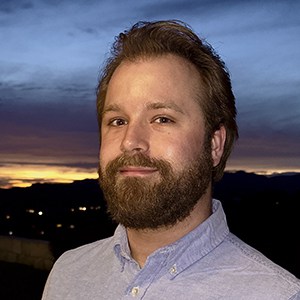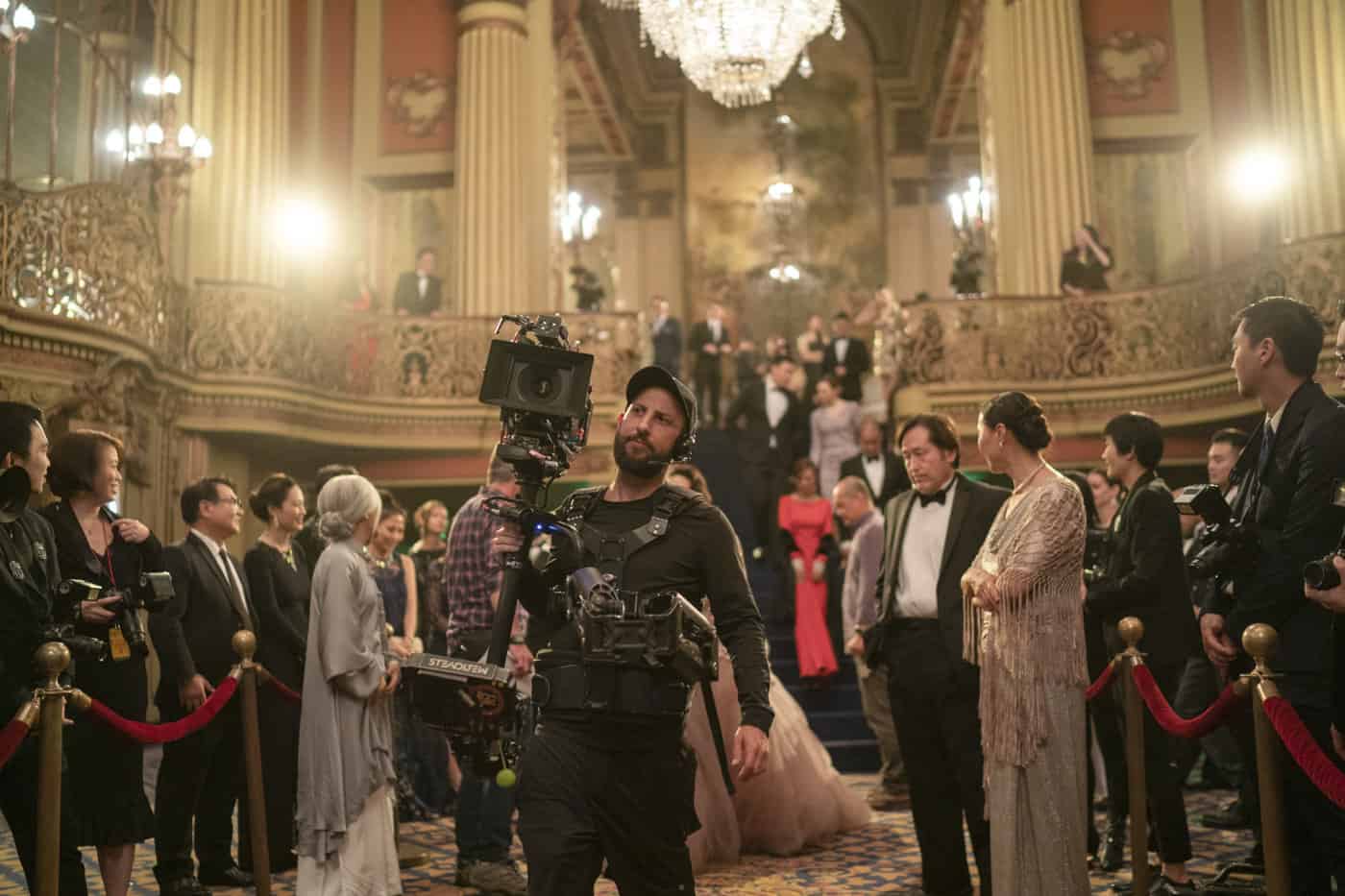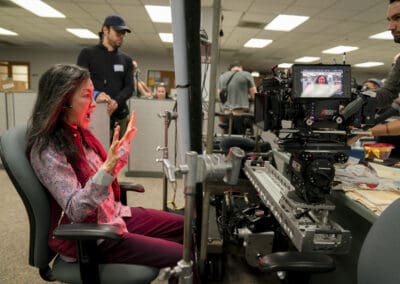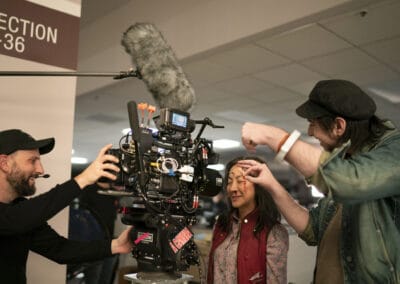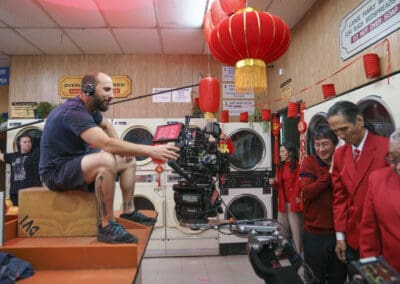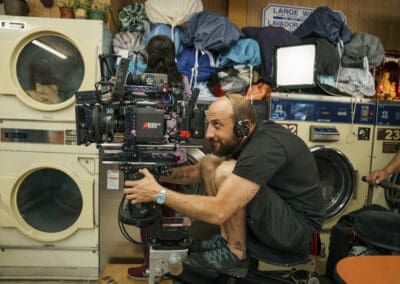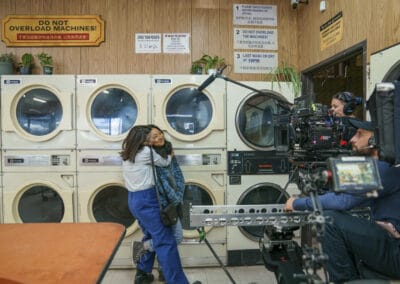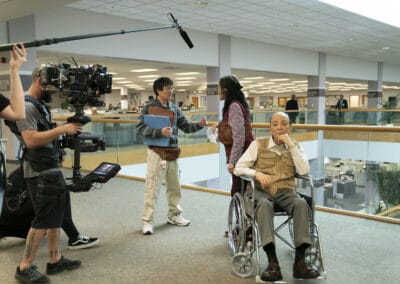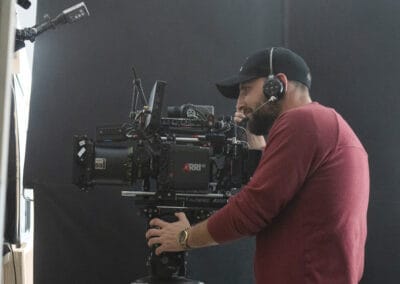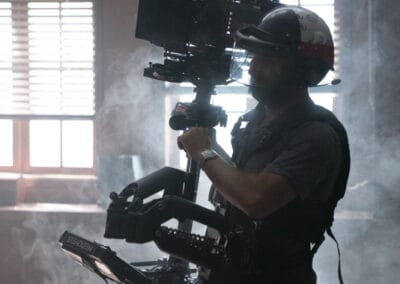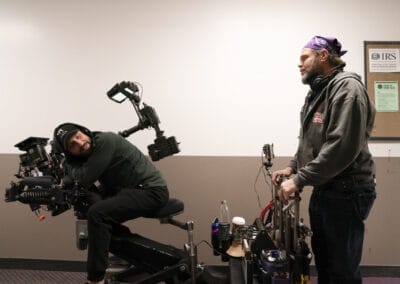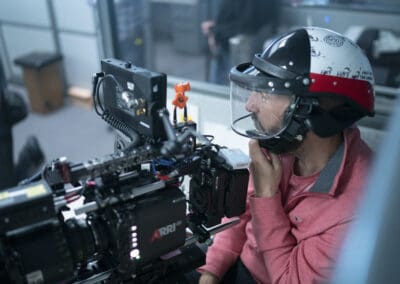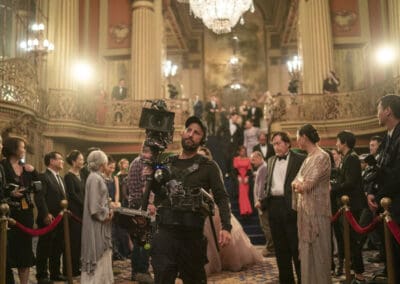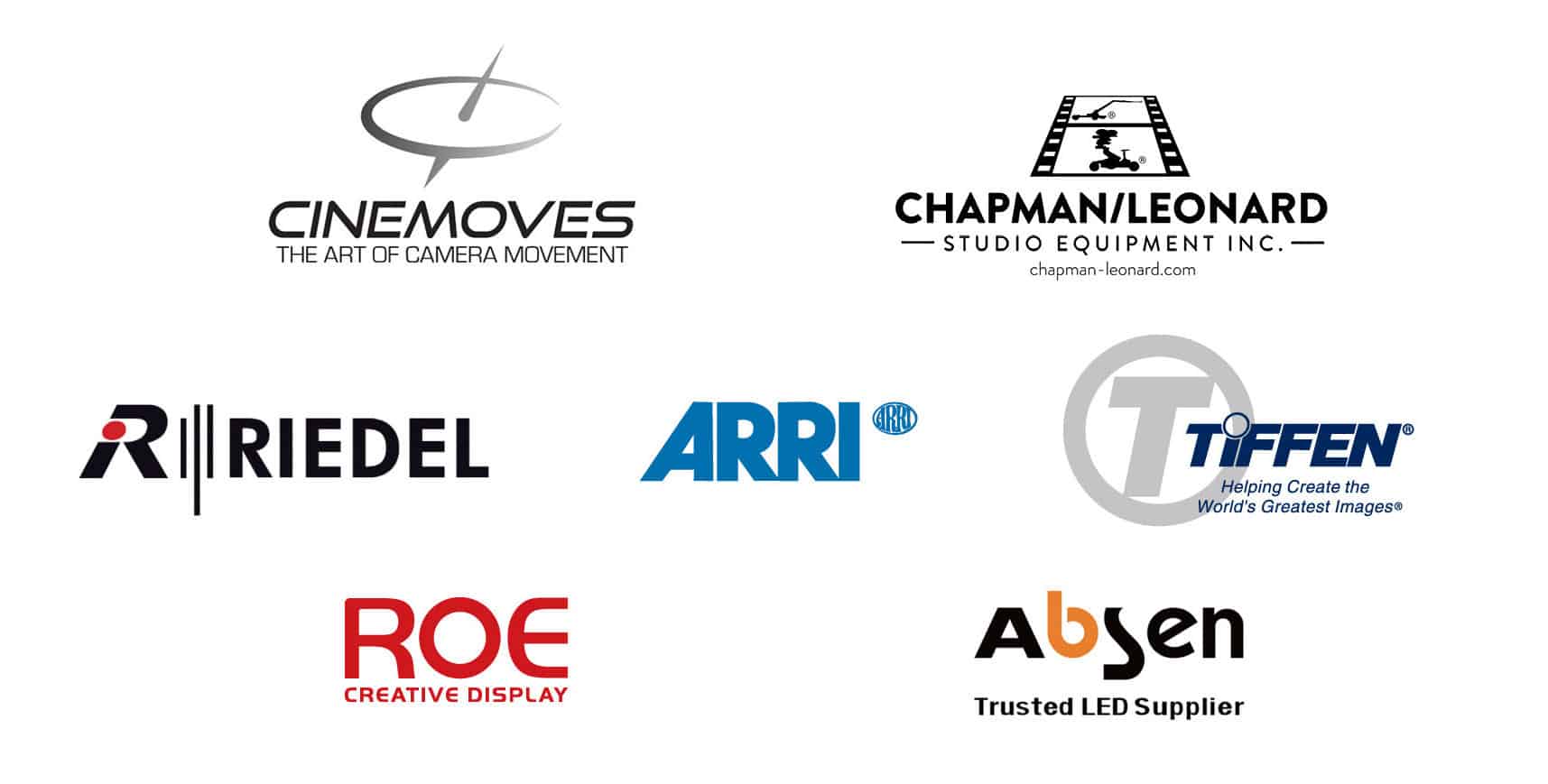Everything Everywhere All at Once:
Making the Most Out of a Little
A Conversation with Ari Robbins, SOC
By David Daut
With a story that spans dozens of realities, Everything Everywhere All at Once follows laundromat owner Evelyn Wang as she struggles with filing her taxes, navigating a pending divorce from her husband, failing to connect with her daughter, and fighting off an incursion from a universe-hopping nihilist who seeks an end to all existence across every version of reality. The film is written and directed by Daniels and stars Michelle Yeoh, Stephanie Hsu, Ke Huy Quan, Jenny Slate, and Harry Shun Jr. with James Hong and Jamie Lee Curtis.
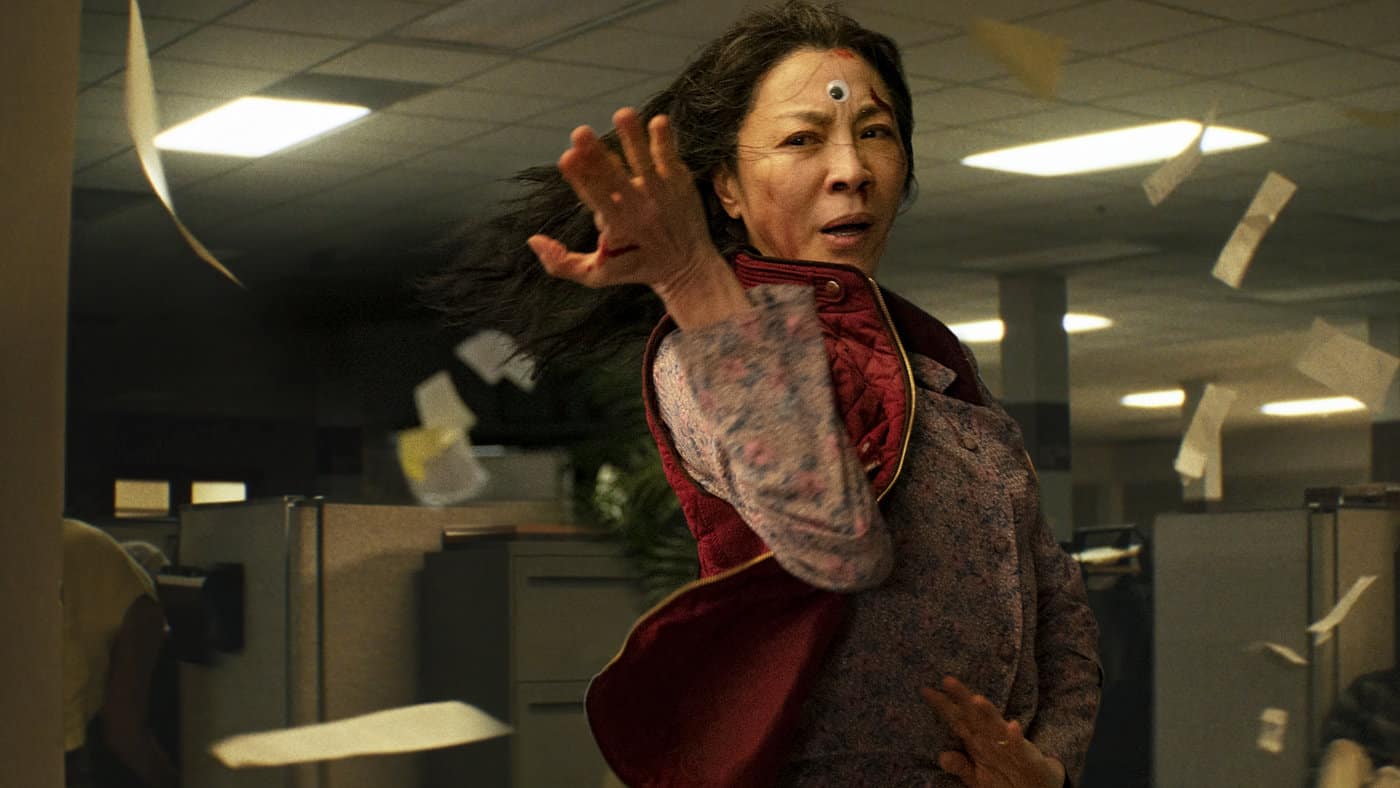
Michele Yeoh in EVERYTHING EVERYWHERE ALL AT ONCE
Camera Operator: Let’s go ahead and jump right in. Tell me a little bit about how you came to be involved with Everything Everywhere All at Once.
Ari Robbins: I joined up with Larkin [Seiple] and Daniels [directors Daniel Kwan and Daniel Scheinert] for Everything Everywhere All at Once because I started working with Larkin many years ago on music videos, and one of the groups of music video people that we worked with was Daniels. This was a while back, before Swiss Army Man. It was the music video generation that I came up with, and Daniels were one of those groups—obviously the most highly creative and interesting of those groups—but that’s where my history with them began. So it was very neat on this film, after working with them for so long, to see them succeed and make something so beautiful.
CO: With that music video history, how would you say that informed the work you all did on this movie? I know a lot of other directors have come out of music videos, like David Fincher, Spike Jonze, Gore Verbinksi. There’s a long lineage of that.
Robbins: Truly it feels like some of the best directors always come from music videos because it’s just a highly creative medium. And for Daniels, every music video for them is just such a showcase of their ability and talent, and then you see how it’s so perfectly transferred into narrative storytelling. But I think they learned a lot of their creative abilities and had opportunities to figure out how to turn something that could be small into something grandiose and wonderful. I think they learned a lot of those principles from their music videos—how can you make the most out of a little, and then how can you make it so engaging? I always think there’s that desire in filmmaking to really just go and reach and push for the audience, but there’s a subtlety that they bring, an ability to do so much with so little, and that’s what I think their music video background helped create.
One of the things that I thought was very interesting, Everything Everywhere was shot in two locations, but you could never tell when you watch the movie. The last thing you would think is that we’re really only in two spots, but I think that’s also true of their music videos. I remember one I did with them, a Tenacious D video—I think we did four shots the entire day. And yet, somehow, there’s this amazing, cool music video with all these like different pieces and parts. That’s what’s very intriguing about them is that they use everything. You can have just a corner of a shot in a frame, and then they’ll zoom into that and take that piece out and utilize it. They’re just geniuses when it comes to collecting all that they need and utilizing every piece.
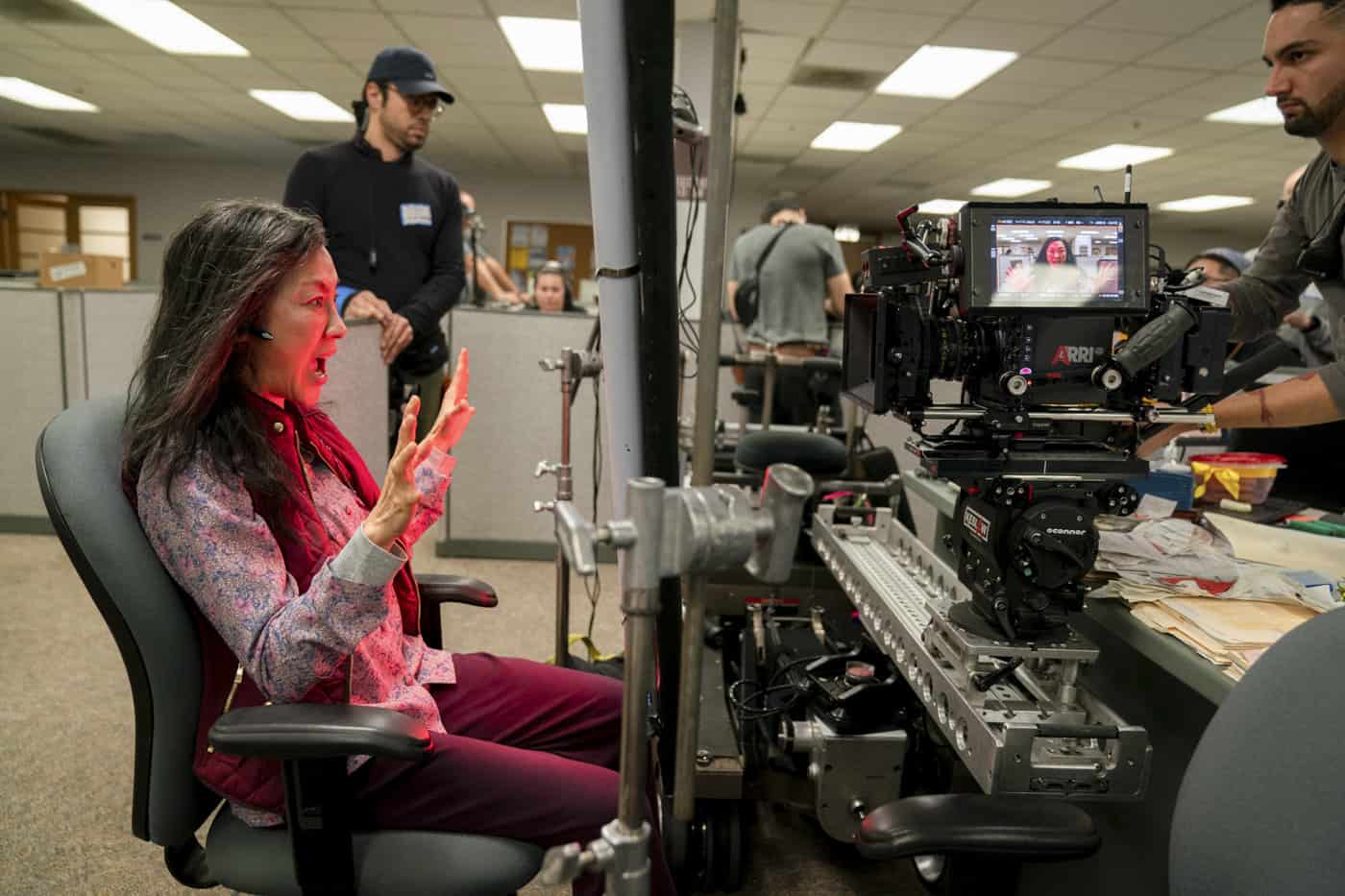
Michelle Yeoh in EVERYTHING EVERYWHERE ALL AT ONCE
CO: Digging into that a little bit, the movie is called Everything Everywhere All at Once and it feels every bit as big as it sounds, so when you do watch it two or three times and realize that a lot of it takes place in just two locations it’s genuinely surprising. Can you talk a little bit about what the production was like and using the resources you had to make it feel like this massive thing?
Robbins: That’s the magic that I think Daniels have. When they have in their mind’s eye what they’re trying to get, it’s very dead specific. It’s like, “this is what we’re looking for, and this is what we need.” And when you think like that and you’re making movies that way, you can build a new set or a new scene in the same room and still tell that story just as well. That was kind of the key to the whole film, but also the challenge, too. You have different wardrobe changes, different looks, different sets, and you’re doing it all in the same place. We would shoot one shot in one scene and then go shoot another shot in another scene and they’d be completely different, but you’d be in the same room getting it done within the same hour.
That’s what was so fascinating about the film; it wasn’t a 70-day movie, I think it was only 30-something days. It was really short, but they maximized everything. Nothing was a waste, nothing was over shot. That’s the cool thing about Daniels, it’s incredible to imagine that they’ve conceived every beat and every moment in their heads, and then you watch it and you go, “how the hell did they think of all of this?” But when you’re doing it with them, you see it happening in real time, and you see how they just know the beats, they know what they want, they know how to tell the joke or sell the moment, and that’s all you get. There’s not a lot of waste with them. There’s no “Well, maybe we’ll get some coverage, or maybe we’ll do a wide shot.” No. This is what this beat is, that is what that beat is. When your director, your cinematographer, and your team can move and know each other that well—because the whole team had been working together for over 15 years—you have that ability to move quickly, to make these very interesting and artistic decisions en masse. Fifteen different setups and styles in one day would have been a normal day.
CO: Wow!
Robbins: It was such a beautiful thing to watch. To be that specific as directors and as a team. That’s the other thing—that they can do this together. It’s just mystifying. It blows your mind every time you watch them do it.
CO: A lot of the multiverse hopping that happens in this movie is accomplished through clever editing tricks, but while filming was there anything you were doing in camera to change the look or feel of these alternate realities?
Robbins: Oh gosh, yeah. We changed just about all the different settings that you can, but a lot of it was in the lighting, too. To me, one of the most interesting ones is the way they lit the faces when you’re seeing characters move through these universes. It was this triangular AsteraBox that they would put right over the lens. As for the match cuts, we always knew where we are and what it is, but you’re thinking in pieces and segments. We could say, “Okay, we have this piece, and we know the frame looks like this. So now we’ll just come over and get that other piece.” I don’t want to say it was easy, but because they know what they’re looking for—and they understood their story so well—it wasn’t hard to do a smash cut or whip pan into another reality. It was all very simple to do. They make the in-camera tricks look so easy. That’s one of the things with Daniels; you give them anything and they’ll turn it into a piece of art. A lot of it felt like it was that appropriate mix of in-camera, as well as lighting. There were a lot of choices to make, but it was a lot of educated decisions on how to do this in and out of camera.
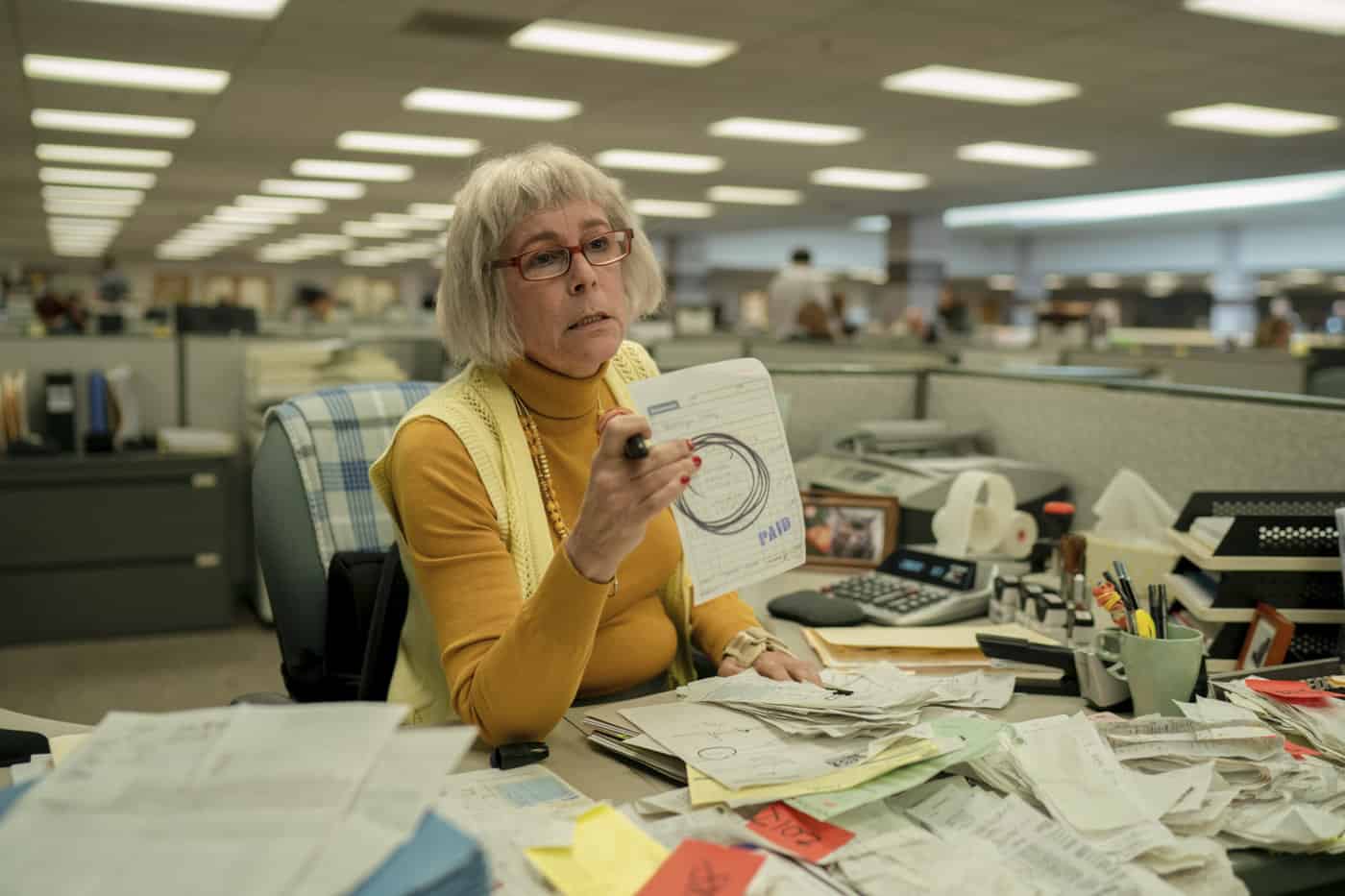
Jamie Lee Curtis in EVERYTHING EVERYWHERE ALL AT ONCE
CO: You talked a little bit about that triangular lighting rig that would fit over the front of the camera, but what sort of other equipment did you use to change up the look? Were you using different lenses for different realities, different cameras, even?
Robbins: We did. I don’t recall if we used too many different cameras—we may have used one or two, I can’t recall off the top of my head—but we definitely did a lot of different lens choices. Larkin had a quite a good list of both modern and vintage lenses to create those different universes. From Todd-AO Anamorphics to Super Speeds, it was a really interesting mix. And that’s something that Larkin has a very long history of doing—understanding how you can mix different lenses to create different formats or styles, different aspect ratios, and how you can tell your story with that. That’s always been something that they’ve been really good at. I think this movie in particular shows how much you can adjust and make variations with basically the same few things. Really that’s a testament to Larkin’s ability. You watch this movie, and you go, “Oh my God, there’s 70 different looks in 100 different locations.” That’s incredibly difficult to put together, but that’s the cool thing with Larkin and Daniels and that longevity of their collaboration is they make that really easy. They’ve just done it so well together for so long that you would be doing all these crazy things on this movie, but it almost just felt normal. It’s just easy.
CO: It sounds like with how much Daniels and Larkin knew the story, knew the style, knew what they wanted, the process was sort of like dominoes falling into place, but were there any parts of the movie that were a little bit more challenging or took a little bit longer to find that moment?
Robbins: Some. I think when we got to the large-scale stuff like the main room of the IRS building, that has a lot of different elements. That last fight sequence with everyone when Evelyn regains consciousness, in every shot Jobu’s in a different outfit. It’s just changing and morphing. That got a little bit difficult just with the blocking and things. Every movie has its challenges, and maybe while we were doing it, it felt challenging, but overall, none of it was too hard. And I guess that’s just good planning.
The other thing is that Daniels—in all of their films and all of their productions—they leave that little bit of freedom and room to say, “Hey, you know what? Maybe we don’t really know exactly what this is, but it’s working. Let’s not try to adjust it.” There’s a certain amount of charm and character that I think they just naturally bring to each moment. So, when you would say to yourself, “Oh boy, where do we put all these people? Where’s the match? How does that work?”
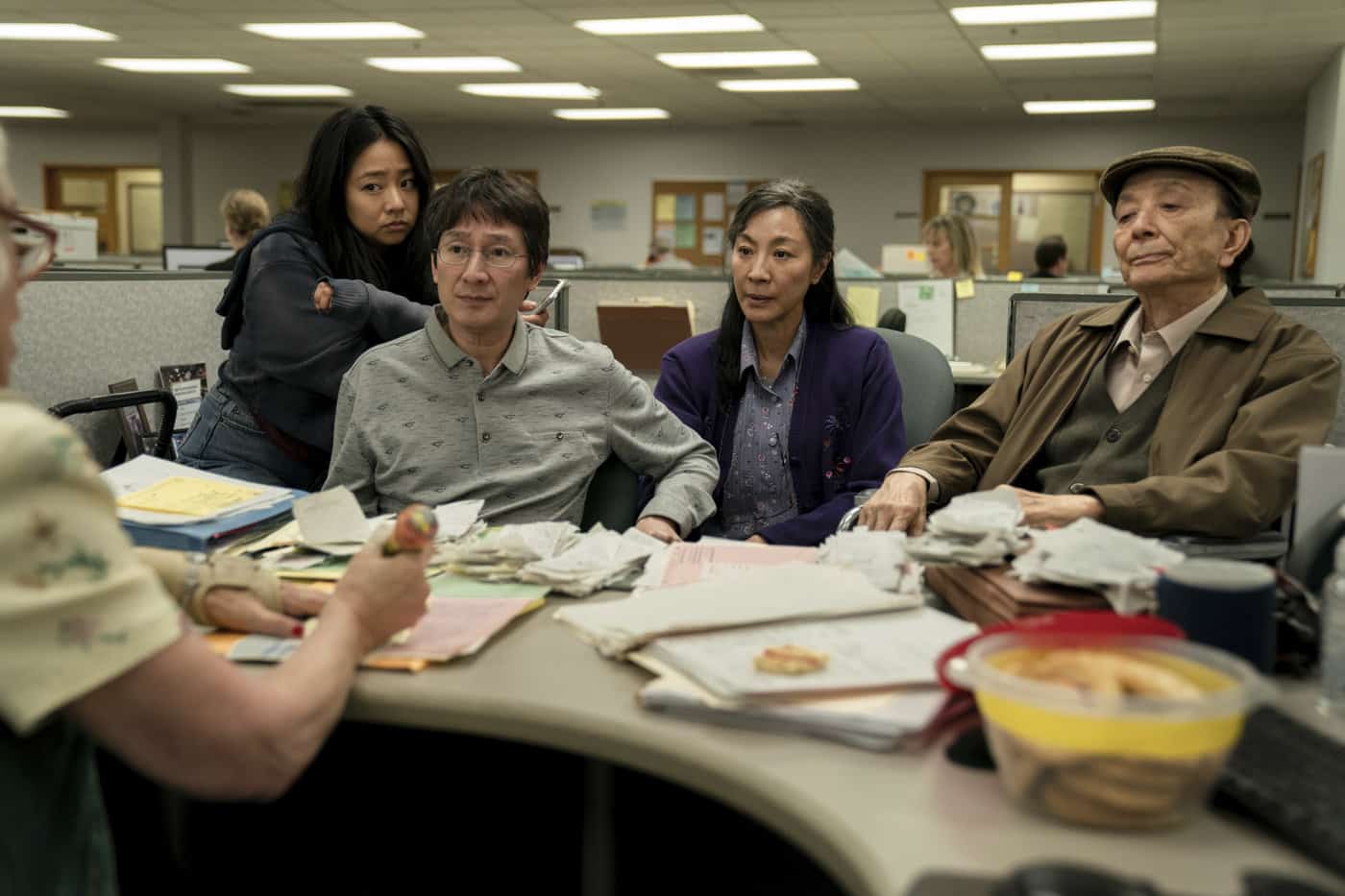
Stephanie Hsu, Ke Huy Quan, Michelle Yeoh and James Hong in EVERYTHING EVERYWHERE ALL AT ONCE
It wasn’t stressful because it comes from a place of enjoying and of appreciating that part of the process. Even those stunt sequences, which look very intense, I think we’d do them in half a day. We were able to work that way because we’re very familiar with the directors, everybody was placed well together before the movie, so when you got into it, it just works. So, when you have people fighting with butt plugs and that whole crazy scene, the logistics of it seem complicated, but when we’re actually on set shooting it, you see the fun and enjoyment of it and you’re able to let it breathe and live.
I think that’s what makes some of those scenes fairly simple to do, but a lot to digest while you’re watching. There was so much simplicity in these fight scenes. The one with the fanny pack is insane, but when you really break it down, it’s not like we had a 50-foot Technocrane and guys jumping in from another building. It’s just a guy fighting three dudes, and it’s comical and beautiful. I think their secret is that it’s not about the complexity, and we really felt that while filming. There were some really complex things to do. One of the scenes where all the lights change, we had to get a guy to re-light the whole hallway, and that’s a lot of work. It was a guy up on stilts all day changing those lights, but they would plan ahead so that when we got over there, we could just do it. That kind of organization and control you only get when you have teams that are that well established. I don’t think any other team could have made this movie like this. It’s what families can do together.
CO: And to your point, the action sequences in this movie are better, frankly, than some movies that cost 10 times as much. I think that comes down to that simplicity you’re talking about and just focusing in on the core of those moments.
Robbins: It almost makes it bigger in a way. I think they’re capitalizing on the moment that audience is feeling and not just creating spectacle for the sake of spectacle. That also plays into their humor and their comedy. You look at this film, and it’s hilarious. In the first hour, you can barely stop laughing, but then by the end, you’re in tears. I think that filmmaking really shows through, and it showed through for us because you’d be there on a 12-hour day, you’ve got 100 shots to do, they’re all different, but it was okay. There’s this thing that Daniels do, and I have to mention it because it’s the cutest, coolest thing I’ve ever seen. Every morning, when we’d start we’d have our safety meeting, and every morning, they would have a goofy stretch or a weird dance or just some little thing where the whole crew would do it together. It might be we’re all going to do the chicken dance today for five minutes before we start shooting. And I just think, how can you not just be in love? How can you start your day with that kind of fun and humor, and not carry that into the work? And I think that’s what let them make a $15 million movie that feels like a $150 million movie. It is that love and it’s true with all of their work.
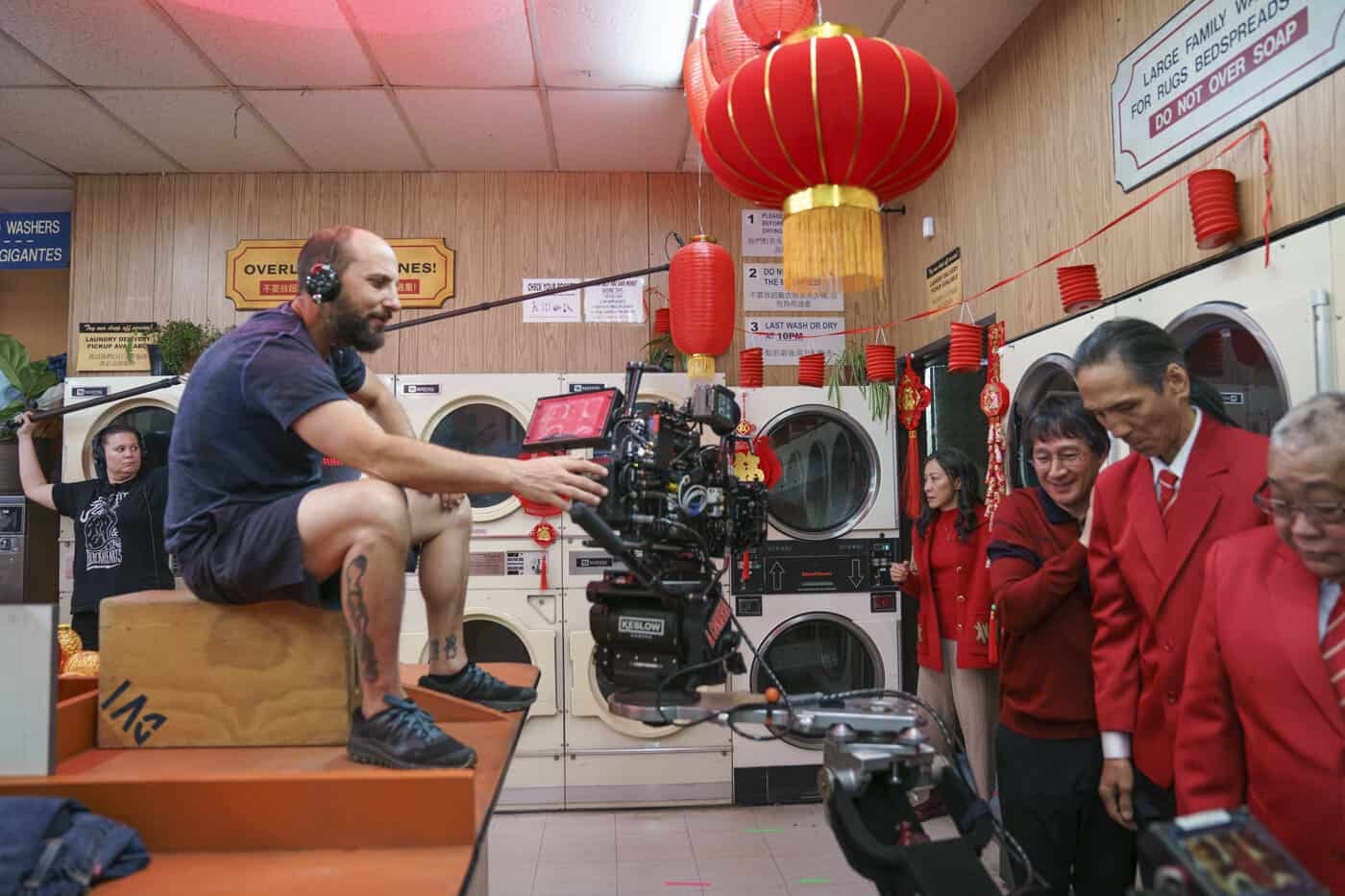
Ari Robbins, SOC, shooting EVERTHING EVERYWHERE ALL AT ONCE
CO: I think that love and that attention definitely shows through in the finished film. I mean, this movie came out in March of 2022 and it still it hasn’t gone away. A lot of times a movie will come out in March and even if it’s really good, you kind of forget about it six months later. There are so many other things competing for your attention. But this has hung on, even in a year that has been jam-packed with incredible films.
Robbins: For this to come out this year, with the level of competition that there is, every article I read, from all sorts of different publications, says the same thing: this is the best movie of the year. And it’s wild because it’s not what we as an American audience would normally gravitate to, but I think people really wanted this film. Emotionally, I think there was a lot that it captured and I think that it tapped into a time and a place that a lot of people felt, and I think that helped. I also think the thing that Daniels do so well is it’s just so humbly, beautifully them. There’s no pretentiousness, there’s no bullshit, it’s just a great ride and a good time, and I think a lot of people need that. I can tell you that when we were filming it—and this was pre-Covid, we wrapped on Friday, and the whole world shut down on Monday—but the entire time we were filming it, I don’t think there was a person there who didn’t know that this movie was going to be everything. You just felt it. The humor was too good, the actors are too good. I mean, you don’t want to get too excited, God forbid, but when we were filming it, we just knew. You can see it in every single thing from the sets to the actors to the people; every joke just hits. You never say to yourself while doing a small, independent movie that this is going to be the Oscar winner of the year, but now that it’s looking like it could be, you go, “Holy shit!” And it would be wonderful because it’s just so rare to see that beauty in filmmaking, that just down-to-earth, enjoyable art. I don’t know what else it is but a damn good time.
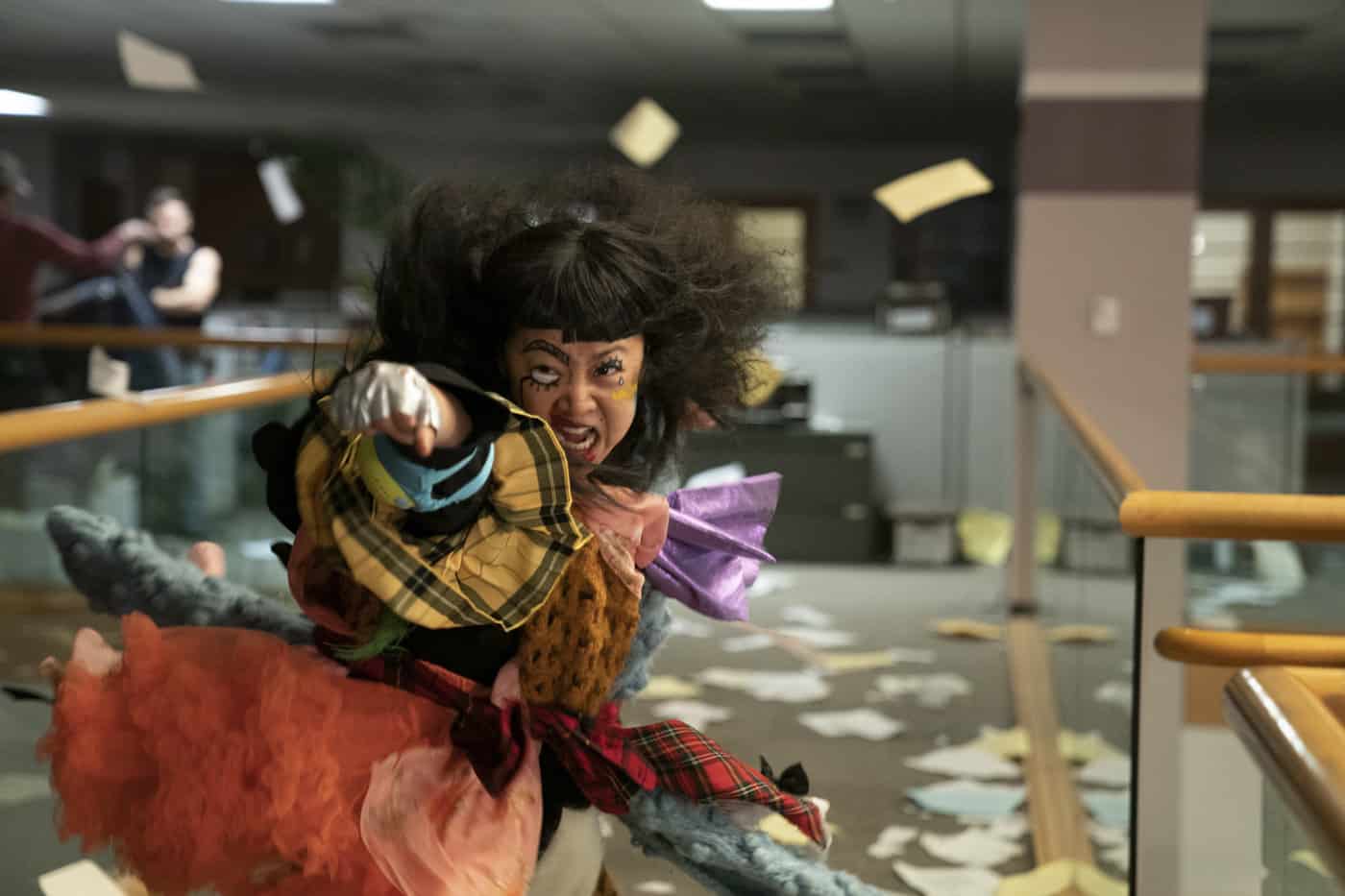
Stephanie Hsu in EVERYTHING EVERYWHERE ALL AT ONCE
CO: I saw it in theaters back in March, and I just rewatched it to prepare for this interview. I knew it was great, but coming back to it again and seeing how excellent every single element of it is, it made me appreciate it all the more. And the work everybody’s doing on it—I mean, Ke Huy Quan is incredible, Michelle Yeoh is incredible, Stephanie Hsu, Jamie Lee Curtis.
Robbins: Sometimes when Jamie Lee Curtis would do the rehearsals, and you’re just watching it, you’re just blown away. You can’t believe you’re watching her stomp around an office in a fight scene. And she always had the belly outfit on, she was just all fun all day, and they all were. You know, you’re working with one of the most well known female actresses of all time, and then you’ve got Michelle who’s just come off Crazy Rich Asians and has never been bigger, and they come into this goofy, weird movie with hot dog fingers and dildos. If you tried to explain it to someone, they’d be like, “Okay, you need to lay off the drugs. That’s a little too intense.” And then there’s Ke, who we all knew as Short Round—that’s who he is to us—but then to watch him be this charming man as well as this action hero, was all really beautiful watch. That’s the fun with Daniels: You’re always going to be surprised about what you’re doing and what it is, but you’re never going to be surprised with how awesome it is. They somehow have a knack for turning anything and everything into something that relates.
I would say the biggest thing to me was having this crew that has such a history together. You have first AC Matt Sanderson organizing everything together—the lenses, the notes, the details, and working with the DIT, Matt Conrad. For most people, the amount of work they do would be too much. But for them, because they’ve been working together for so long, it was easy. It wasn’t a four-camera shoot with 10 ACs. It was a first, it was a second, and it was a DIT, and they killed it. And Matt Ardine, the gaffer, he’s been with them forever. He’s in one of their music videos—I think all of Daniels’ crew were in one of their music videos at some point, which is a really great treat. I don’t know how else you could make this movie, changing out all the lights, creating those new looks. I don’t think you could ever find another group of humans to put in a room to make something like this. That’s just a Daniels collection. They bring those kinds of people with them who know how to do it.
When I really think about how I relate it to us as an industry, us as operators, we spend so much of our careers figuring out how to make everything, how to make an imaginary thing come to life. There’s always this perception that you have to be at a certain echelon or level in order to create, and I think that’s what makes this movie so important. It shows all of us—operators, gaffers, designers, hair, makeup, wardrobe—that if the passion and the love is there, you’re gonna succeed. I think that is absolutely what this movie is about. The biggest thing is that it really takes that kind of passion, it takes that kind of heart, and sometimes that might be hard to find on Transformers 10, but when these opportunities come along when you get a group of artists, and you get to be with a group like this, you have to cherish it and stick with it through and through because there’s nothing else like it.
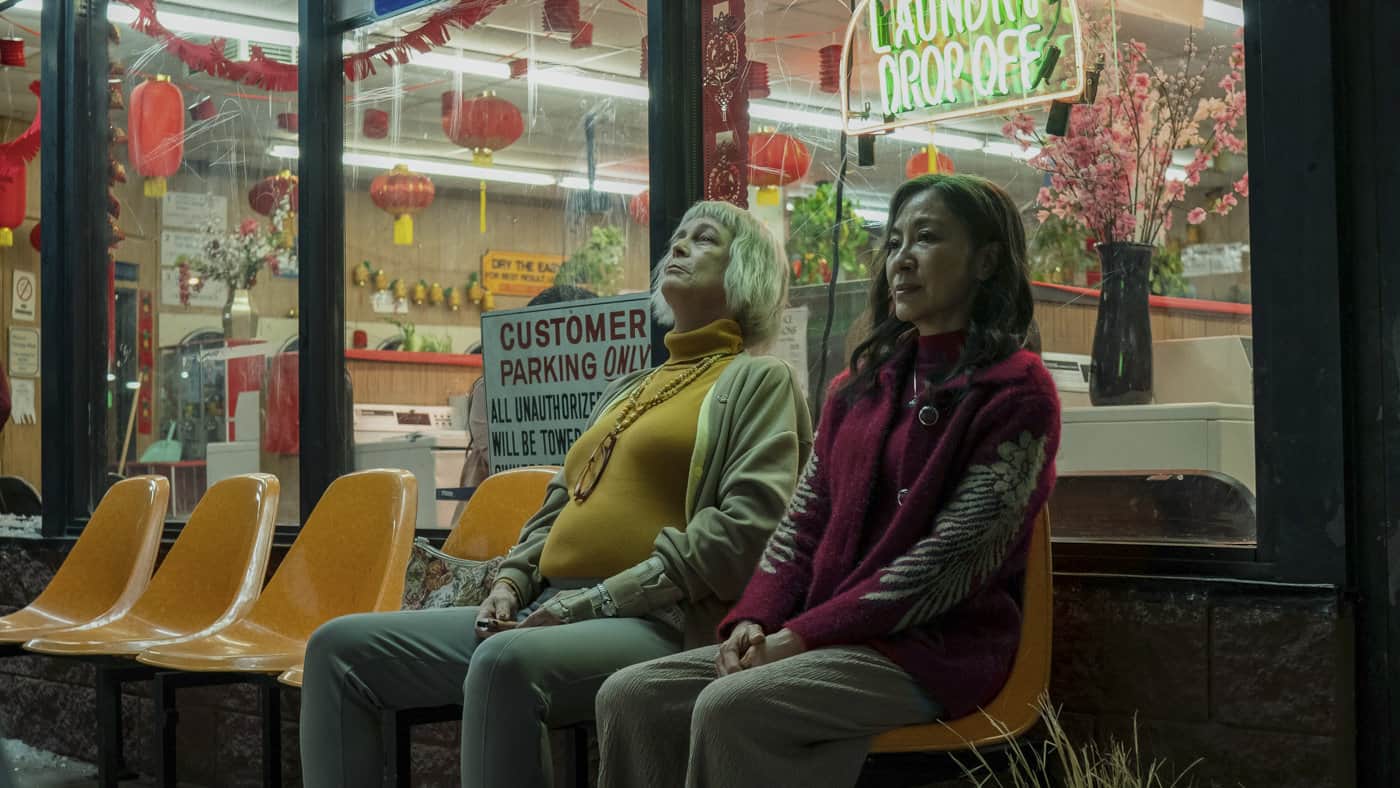
Jamie Lee Curtis and Michelle Yeoh in in EVERYTHING EVERYWHERE ALL AT ONCE
Camera Operator Winter 2023
Above Photo: Camera operator Ari Robbins, SOC, on the set of EVERYTHING EVERYWHERE ALL AT ONCE
Photos by Allyson Riggs/A24
TECH ON SET
AsteraBox
Todd AO Anamorphic Lenses
Zeiss Super Speed Lenses
RELATED CONTENT
Watch the Trailer for Everything Everywhere All at Once
Ari Robbins, SOC
BEHIND THE SCENES
Select Photo for Slideshow
Ari Robbins, SOC
Ari Robbins was first introduced to Steadicam at the age of 18 after returning home from high school. Knowing his future lay within the cinematic industry, he was immediately entranced by the notion of operator and equipment working together so intimately. It was a culmination of all things he was looking for: a career, a hobby, a profession, but most importantly, a passion. Ari moved to Los Angeles and immediately began working in the lighting departments. In the fall of 2004 he signed up for a Steadicam Operators Association workshop. After graduating, he searched and found his ideal rig and, on his 21st birthday, purchased his Steadicam. That same day, he rolled his first shot on set as a Steadicam operator and owner. Ari operates with the same enthusiasm he had the first moment he strapped on his vest, with passion first and the camera second.
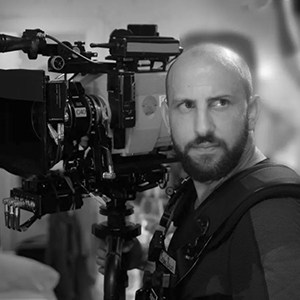
David Daut
A writer and critic for more than a decade, David Daut specializes in analysis of genre cinema and immersive media. In addition to his work for Camera Operator and other publications, David is also the co-creator of Hollow Medium, a “recovered audio” ghost story podcast. David studied at the USC School of Cinematic Arts and works as a freelance writer based out of Orange County, California.
